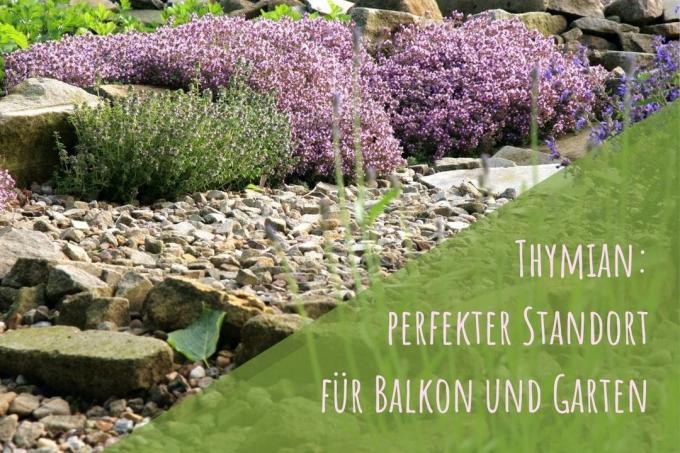
table of contents
- Location in the garden
- Location for balcony
- Important conditions
- frequently asked Questions
Thyme has the botanical name Thymus vulgaris and is one of the Mediterranean herbs and therefore needs a suitable location. The resistant plant thrives on the balcony as well as in the garden if the conditions at the location are right.
In a nutshell
- Aromatic plant from the Mediterranean region
- loves locations with warmth and lots of sun
- does not tolerate strong wind and rain
- grows splendidly both in the garden bed and in the pot
- gets along with poor soil quality
Location in the garden
Most of the thyme varieties come from the countries around the Mediterranean. This is why the aromatic herb plant is used to warm temperatures and little rain in the summer months. For these reasons, the thyme location in the home garden should correspond to these site conditions. Although the plant is quite frost-hardy and tolerates normal winters in Germany, it does not cope particularly well with the hard and long winters in the high mountains. The herbs can be used to frame flower beds and garden paths as borders and boundaries. Furthermore, with a larger number, it is possible to create a fragrant hedge and a fragrant lawn.

- Ideally suited for the warmer wine-growing regions
- Looks good in Mediterranean-themed gardens
- Also suitable for heather and rock gardens
- Prefers bright, sunny to full sun locations
- Needs at least half a day of full sun
- Protection against too much wind and rain is ideal
- Plant either in front of the house wall or next to a wall
- Stones give off stored heat in the evening and at night
Tip: You can also use the thyme in the top areas of a Herb spiral settle when they get enough sun rays.
Location for balcony
Almost all thyme varieties are also suitable for cultivation in vessels on the balcony. The thyme does not feel particularly comfortable on the windowsill in closed rooms, but needs a place in the fresh air in summer. However, it is better to move the plant indoors in the cold winter months. In the homely outdoor areas, thyme is dependent on similar conditions at the location as in the garden areas. Since the vigorous plant develops a widely branched and deeply reaching root system over time, the planter must not be too small. This is the only way to ensure an adequate supply of nutrients and water even in dry phases. Otherwise, the thyme stops growing very quickly and only thrives poorly.
- Choose a sunny spot as possible
- Depends on protection from the elements
- The ideal location is directly in front of walls and windows
- The bucket must be big enough and deep
- Repot regularly to make room for roots
- Only partially hardy, needs winter quarters
- Unused guest rooms and bright hallways are ideal for this

Note: The plant should not be placed directly in a flower box on the balcony parapet, as it is not sufficiently protected from the elements there.
Important conditions
Thyme is a true survivor and is used to poor soil quality from its home in southern Europe. Thanks to the extremely deep-growing taproot, the herb can supply itself with sufficient water and nutrients even in nutrient-poor locations with dry phases. That's why it survives some time without casting units, for example when vacationing.
- Prefers well drained, loose and sandy soil
- Heavy and loamy soils are not suitable
- But can be loosened up with sand
- A neutral to basic pH value, from 7 to 8, is ideal
- Is happy about lime in the ground
- Plant substrate should be moderately dry to dry
- Does not tolerate long-term waterlogging
frequently asked Questions
Most thyme varieties go well with almost all other Mediterranean herbs, just not with marjoram. There should be enough space in the herb bed or in the herb spiral between these two plants. They shouldn't grow together in one planter either.
Since the thyme has evergreen foliage, it can be sensitive to strong frosts and icy gusts of wind. Therefore, the plants in exposed locations should be covered with some fir twigs or a warming fleece as frost protection.
In the case of creeping thyme varieties, it is advisable to plant them on the edge of garden beds and herb pots that face the sun. Otherwise it can happen that the plants are covered by higher growing neighbors and do not thrive well in the resulting shade.
The varieties bergamot thyme, cascade thyme, caraway thyme, ball thyme, lavender thyme and lemon thyme are particularly robust, grow vigorously and bloom. That is why they are able to cope with the demanding local conditions in the local latitudes.



